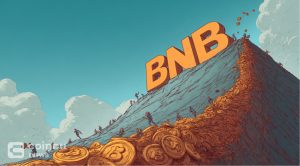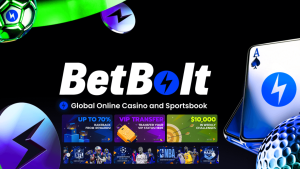How to Spot Trading in Binance: Detailed Guide For Beginners To Join In Easily
Spot trading is a way for newcomers as well as holders to enter the cryptocurrency market. Today, let’s learn with Coincu how to Spot Trading in Binance through this article.

But first, we need to learn some concepts related to spot trading.
What Is Spot Market in Crypto?
In the realm of cryptocurrency trading, the fundamental arena where assets are swiftly exchanged and finalized is known as the spot market. This facet of trading involves the acquisition of digital currencies such as Bitcoin or various altcoins, with investors typically holding onto these assets until their values appreciate.
Spot trading garners its name from the immediate settlement of transactions that occurs within this market. Essentially, spot markets comprise sellers, buyers, and order books, forming a dynamic ecosystem for crypto exchange.
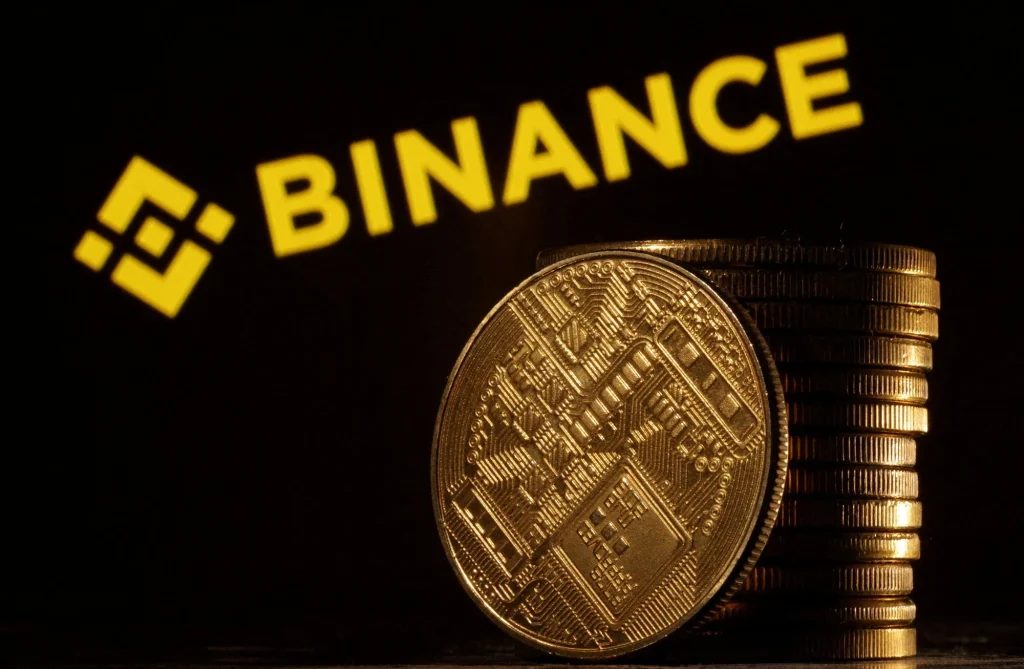
Buyers and Sellers
Sellers initiate orders with specific ask or sell prices, while buyers submit orders with designated bid or purchase prices. The bid price represents the highest amount a buyer is willing to pay, whereas the ask price denotes the lowest value a seller is willing to accept in exchange.
Order book
Central to the spot market’s functionality is the order book, which encompasses two key sides: the ask side catering to buyers seeking to purchase, and the bid side accommodating sellers aiming to offload their holdings. Within this order book, bids and asks are meticulously recorded, outlining the prevailing market dynamics and facilitating seamless transactions.
Types of Spot Market in Crypto
Within the domain of the crypto spot market, there exist two primary classifications: crypto exchanges and Over-the-Counter (OTC) trading avenues. Crypto exchanges serve as hubs where buyers and sellers converge to execute transactions at prevailing market rates. These exchanges provide a structured environment for trading various digital assets, offering liquidity and accessibility to a broad spectrum of investors.
In contrast, OTC trading represents a direct engagement between two parties, circumventing the intermediary role of an exchange. This direct interaction fosters a higher degree of flexibility in negotiating transaction terms, particularly concerning price and volume, which is particularly advantageous for large-volume trades. OTC trading enables counterparties to tailor agreements to their specific needs, often catering to institutional investors or individuals seeking specialized terms for significant transactions.
What Is Spot Trading in Crypto?
Spot trading, a fundamental aspect of the financial market, involves the direct buying and selling of financial assets such as cryptocurrencies, stocks, forex, and bonds.
Unlike other forms of trading, spot trading ensures immediate delivery of the purchased asset, creating a fast-paced environment conducive to swift transactions. Typically hosted on exchanges or facilitated through over-the-counter interfaces, spot markets offer traders the opportunity to utilize their assets without the involvement of margins or leverage.
A distinguishing feature of spot markets is their accessibility to all traders, allowing anyone to participate in trading activities. Additionally, assets are readily available, and traders have the option to use cash payments, leading some to refer to spot markets as cash markets. This accessibility and immediacy make spot trading an attractive option for investors seeking simplicity and direct engagement in the market.

Centralized exchanges such as Binance or Coinbase play a crucial role in managing spot trading interfaces, and ensuring regulatory compliance, security, and custody of assets. Transaction fees paid by spot traders contribute to the operation of these exchanges. Alternatively, decentralized exchanges operate on blockchain smart contracts, offering a similar service but with a decentralized framework.
In the cryptocurrency industry, spot trading serves as the most straightforward method of investing and is often the initial transaction for individuals looking to acquire and hold digital assets. However, spot markets are not exclusive to cryptocurrencies; they also exist in traditional markets, encompassing bonds, forex, and shares.
Read more: Binance Account: Detailed Instructions On How To Delete Safely
How to Use Binance Spot Trading?
Binance offers a user-friendly spot trading platform for individuals looking to engage in crypto trading. With a step-by-step process, users can easily navigate through the platform to execute their trades efficiently.
To begin Binance Spot Trading, users first need to register and confirm their identity. Once logged in, they can follow these simple steps:
Step 1: Upon reaching the Binance homepage post-registration and identity confirmation, users should hover their cursor over the “Trade” navigation bar and select “Spot” from the drop-down menu.
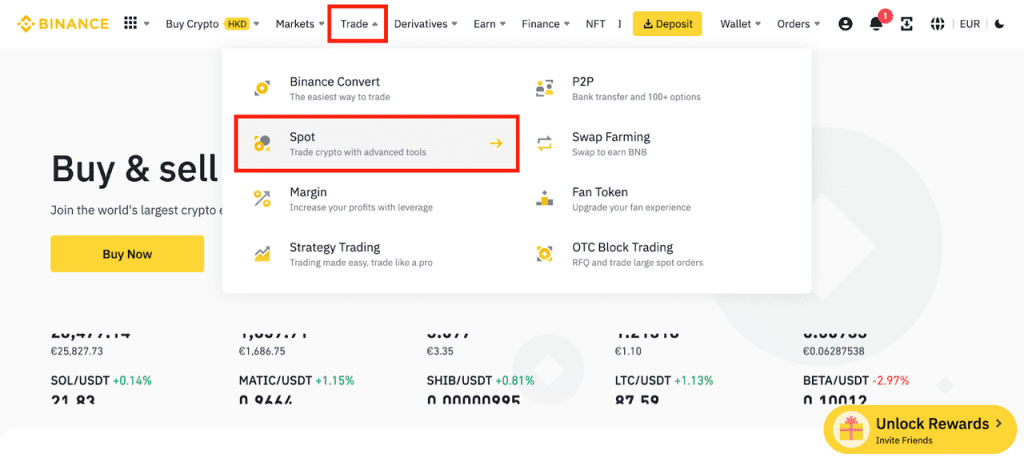
Step 2: This action redirects users to the Spot trading interface, where they are greeted with a comprehensive trading view. This interface comprises various sections tailored to accommodate different trading functionalities.
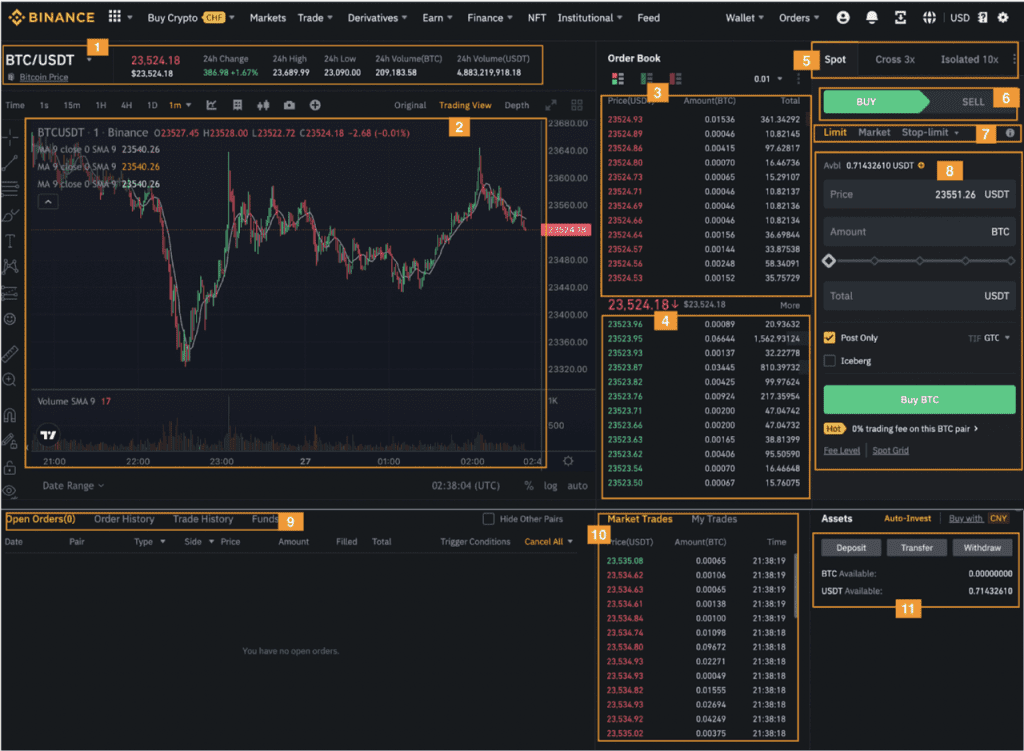
- (1) Trading volume of the trading pair in 24 hours
- (2) Candlestick chart and market depth
- (3) Sell order book
- (4) Buy order book
- (5) Trading Type: Spot/Cross Margin/Isolated Margin
- (6) Buy/Sell switch
- (7) Order type: Limit/Market/Stop-limit/OCO(One-Cancels-the-Other)/Trailing Stop
- (8) Buy/Sell order section
- (9) Open orders, order history, trade history
- (10) Market Trades and My Trades
- (11) Spot Wallet balance
Step 3: For instance, let’s consider the process of purchasing Binance Coin (BNB). Users can select a suitable BNB trading pair, such as BNB/USDT, from the available options.

Step 4: Next, users should navigate to the top right corner of the screen and click on “Spot,” then choose “Buy.” Here, they have the option to select from different order types, including “Limit,” “Market,” or “Stop-limit.” After selecting the preferred order type, users can enter the desired price and quantity of BNB they wish to purchase. Additionally, users can customize the order by adjusting the percentage of their Spot Wallet balance to be utilized for the transaction.
Step 5: Once all parameters are set, users can finalize the process by clicking “Buy BNB” to place the order.

By following these straightforward steps, users can seamlessly engage in spot trading on Binance, accessing a diverse range of cryptocurrencies with ease and convenience.
Note:
- The default order type is a limit order. You can use a market order if you want an order filled as soon as possible.
- If the market price of BNB is 400 USDT, but you want to buy at a specific price, for example, 308 USDT, you can place a limit order. Your limit order will be executed when the market price reaches your set price.
Read more: Binance Review: The Top Largest Crypto Exchange In The World
How Does Crypto Spot Trading Work?
On CEXs
Spot market transactions, particularly on platforms like Binance, involve several key elements essential for traders to grasp for successful trading endeavors. Understanding these aspects, including the spot price, market orders, and volume, is crucial for navigating the complexities of cryptocurrency trading.
Spot price and market orders
The spot price, representing the current market value of a digital asset, serves as the baseline for transactions on platforms like Binance. Market orders enable traders to buy or sell their crypto holdings at the best available spot price.
However, given the volatile nature of cryptocurrencies, the price listed on the order book can fluctuate rapidly, presenting a degree of uncertainty regarding the execution of market orders.
Volume
Moreover, insufficient volume can pose challenges in filling orders at desired prices. For instance, if a trader places an order for 10 BTC at the spot price but only 5 BTC are available, the order may be filled gradually at varying prices until the desired volume is reached. Spot prices are dynamic, updating in real-time based on order matches, influencing the execution of transactions.
On DEXs
Distinguishing between centralized and decentralized exchanges is imperative for traders. Decentralized exchanges offer greater privacy and autonomy but also entail higher risks due to factors such as the lack of Know Your Customer (KYC) protocols and Anti-Money Laundering (AML) policies. Notably, decentralized exchanges like Binance DEX utilize order books, albeit with variations compared to centralized counterparts.
Recent innovations such as Pancake Swap and Uniswap’s Automated Market Maker (AMM) introduce novel approaches to trading. AMMs leverage smart contract technology to facilitate asset swaps, with liquidity providers earning transaction fees from users accessing liquidity pools. These developments underscore the evolving landscape of cryptocurrency trading, offering alternative mechanisms for engaging in spot market transactions.
Advantages of Binance Spot Trading
Unlike futures markets, where prices derive from multiple reference points such as moving averages and funding rates, Binance Spot Trading relies solely on the forces of supply and demand. This transparency simplifies price tracking, making it easier for traders to gauge market movements and make informed decisions.
Binance Spot Trading is renowned for its directness and simplicity. With minimal rules and low associated risks, traders can easily calculate potential gains and losses based on entry and current prices. This straightforward approach appeals to both novice and experienced traders alike, fostering a more accessible trading environment.
One of the most significant advantages of Binance Spot Trading is the absence of liquidation risk. Unlike margin and derivatives trading, where traders face the possibility of substantial losses and liquidation, spot trading allows for greater flexibility.
Traders can enter and exit positions at their convenience without the fear of sudden liquidation, making spot trading an ideal avenue for long-term investment strategies, commonly referred to as “buy and hodl.”
Binance Spot Trading presents traders with the advantage of low fees, offering competitive rates across a diverse array of cryptocurrency token pairs. By leveraging this platform, traders can benefit from cost-effective transactions while accessing a wide spectrum of digital assets.
Binance’s commitment to providing affordable trading fees enhances the accessibility of spot trading for both novice and experienced traders alike. This cost efficiency contributes to making Binance a preferred choice among cryptocurrency enthusiasts seeking to optimize their trading experience and maximize their returns.
Disadvantages of Binance Spot Trading
One notable disadvantage of Binance Spot Trading is the inherent limitations associated with certain assets. Unlike traditional financial markets where spot purchases may involve physical delivery, cryptocurrency spot trading requires users to secure their assets in digital wallets, either through cold or hot storage methods. This responsibility adds an additional layer of complexity and security considerations for traders.
In certain scenarios, stability is paramount for both individuals and companies. For instance, businesses operating internationally rely on access to foreign currency in the forex market to mitigate currency risk. However, relying solely on the spot market for currency exchange can introduce significant volatility into financial planning and revenue projections, potentially impacting overall stability and profitability.
Another disadvantage of Binance Spot Trading is the comparatively lower profit potential when compared to trading on margin or futures markets. Margin and futures trading offer the opportunity to leverage capital and trade larger positions, potentially resulting in higher returns. In contrast, spot trading limits traders to the actual value of their assets, restricting their ability to amplify gains through leverage.
How to Spot Trading in Binance: FAQs
Where can you use Binance Spot Trading?
Apart from traditional spot trading on exchanges, individuals have various alternatives at their disposal. One such option is utilizing an OTC solution, which provides a direct means of trading assets outside of the exchange’s order book system.
Additionally, traders can opt for peer-to-peer trading, engaging directly with other individuals without intermediary involvement. Another avenue gaining traction is Binance DEX, where users can execute trades through DeFi wallets, ensuring a decentralized and trustless trading environment.
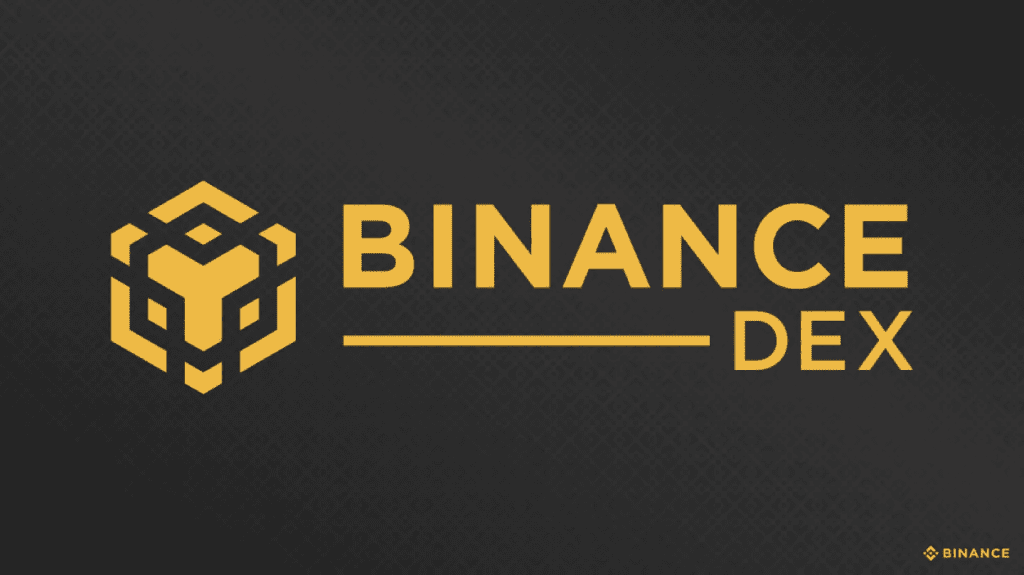
Each of these trading platforms boasts its unique features and benefits, catering to different preferences and requirements of traders. While traditional spot trading offers liquidity and ease of access to a wide range of assets, OTC solutions provide personalized and often more discreet trading experiences. On the other hand, decentralized exchanges prioritize security and autonomy by eliminating the need for a central authority, offering users full control over their funds and transactions.
What are Binance Spot Trading Bots?
Binance Spot Trading Bots streamline the buying and selling of cryptocurrencies on the Spot market through automation. These bots are meticulously crafted to execute trades based on predefined parameters and strategies, effectively reducing manual intervention and enhancing trading efficiency. Currently, Binance offers a range of Spot Trading Bots tailored to meet various trading objectives and preferences.
The Spot Grid Bot operates by dividing the trading range into multiple grid levels, allowing users to capitalize on price fluctuations within the predefined range. This strategy aims to profit from market volatility while mitigating risks through systematic grid trading.
Spot Dollar-Cost Averaging (DCA) Bot enables users to invest in cryptocurrencies regularly by allocating a fixed amount of funds at predefined intervals, irrespective of market conditions. This approach promotes disciplined investing and helps in smoothing out market fluctuations over time.
The Rebalancing Bot automatically adjusts the portfolio allocation of cryptocurrencies based on predefined weightings or criteria. By maintaining a balanced portfolio, this bot helps in optimizing returns while managing risk exposure effectively.
Why are users not able to place a trade at a much lower or higher price than the current market price?
For cryptocurrency pairs, orders must fall within a range of 20% to 500% of the current market price. This ensures that orders are reasonably aligned with prevailing market conditions while allowing for flexibility in price variation to accommodate fluctuations and diverse trading strategies.
Conversely, for fiat-to-stablecoin trading pairs, orders are constrained within a narrower range of 80% to 120% of the current market price. This tighter restriction aims to maintain stability in trading pairs involving fiat and stablecoins, where price volatility may have more significant implications for traders.
| DISCLAIMER: The information on this website is provided as general market commentary and does not constitute investment advice. We encourage you to do your own research before investing. |








